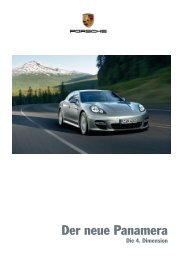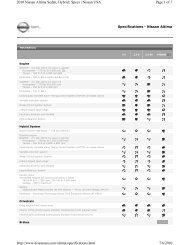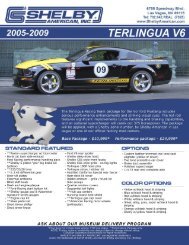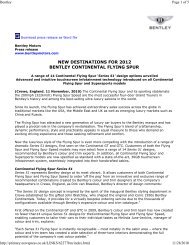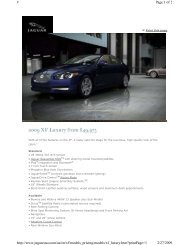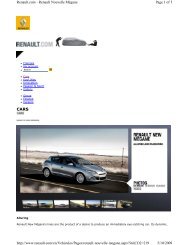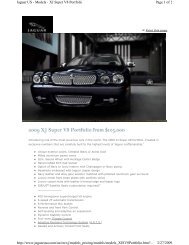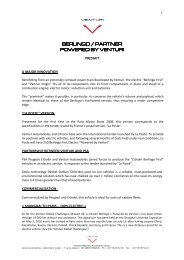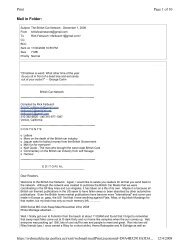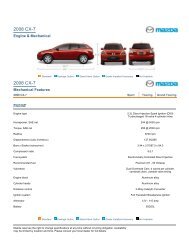The 1955 DeSoto Adventurer II followed the unsuccessful 1954 ...
The 1955 DeSoto Adventurer II followed the unsuccessful 1954 ...
The 1955 DeSoto Adventurer II followed the unsuccessful 1954 ...
You also want an ePaper? Increase the reach of your titles
YUMPU automatically turns print PDFs into web optimized ePapers that Google loves.
Immediately after <strong>the</strong> war and prior<br />
to his tenure at Ghia, Savonuzzi had<br />
created <strong>the</strong> shapes and characteristic<br />
oval grille with vertical bars on <strong>the</strong><br />
iconic Cisitalia 202, which was<br />
subsequently built by Pinin Farina<br />
with restyled rear fenders. At Ghia,<br />
Savonuzzi continued his stylistic<br />
creativity with <strong>the</strong> dart-shaped Gilda<br />
show car and <strong>the</strong> hugely influential<br />
Supersonic series of bodies on Fiat<br />
8V, Aston Martin and Jaguar chassis, details of which showed<br />
up on <strong>the</strong> Volkswagen Karmann-Ghia coupe and <strong>the</strong> Volvo<br />
P-1800 coupes. Its side surface treatment was repeated on <strong>the</strong><br />
Volvo and even on 1958 Chevrolets, hard as that may be to<br />
imagine. General Motors Styling Vice President Harley Earl<br />
always made it a point to attend European motor shows, and<br />
when he saw something he liked, he returned home with <strong>the</strong><br />
idea. In <strong>the</strong> case of <strong>the</strong> Supersonic, he returned with an actual<br />
Fiat 8V with Ghia bodywork and told his stylists to put <strong>the</strong><br />
“boom” (<strong>the</strong> long tubular projection starting on <strong>the</strong> front fender)<br />
on <strong>the</strong> mass-market car.<br />
Above: <strong>The</strong> streamlined <strong>1955</strong> Ghia Gilda Coupe concept was built for<br />
<strong>the</strong> Turin Motor Show in <strong>1955</strong>. Designed by Giovanni Savonuzzi, Ghia’s<br />
chief-stylist, for Virgil Exner at Chrysler, <strong>the</strong> car was an experiment in<br />
aerodynamics.<br />
O<strong>the</strong>r Savonuzzi<br />
projects included a<br />
Cadillac coupe made<br />
for film star Rita<br />
Hayworth; an Alfa<br />
Romeo 1900 coupe;<br />
some 18 Chrysler<br />
show cars done with<br />
<strong>the</strong> collaboration<br />
of Chrysler stylist<br />
Virgil Exner (<strong>the</strong><br />
Volkswagen Karmann-Ghia coupe was done while Exner was<br />
in Torino on Chrysler business); <strong>the</strong> Ferrari 410 Superamerica<br />
on <strong>the</strong> show field today; and <strong>the</strong> Dual-Ghia—also present<br />
here—built on Chrysler mechanicals for American bus manufacturer<br />
Paul Farago. That’s <strong>the</strong> Dual that became <strong>the</strong> car of<br />
choice for <strong>the</strong> Hollywood “Rat Pack,” with Frank Sinatra,<br />
Dean Martin and Sammy Davis Jr. It is worth noting that <strong>the</strong><br />
disposition of <strong>the</strong> frontal elements of <strong>the</strong> Dual derived from<br />
<strong>the</strong> Alfa Romeo 1900, with its vertical grille transmuted into<br />
<strong>the</strong> large, high rectangle of <strong>the</strong> 1953 Dodge Firebomb. It also<br />
clearly inspired <strong>the</strong> decade-later Ford Mustang.<br />
Newly graduated American architect Tom Tjaarda entered<br />
Ghia just as Savonuzzi was leaving for America, where he<br />
would create Chrysler’s gas turbine car before becoming chief<br />
technologist for that entire corporation. Only Sergio Sartorelli<br />
remained as a Ghia designer, so Tjaarda was immediately<br />
given <strong>the</strong> job of creating <strong>the</strong> Innocenti 950 Spyder, a lovely<br />
little roadster based on <strong>the</strong> Austin-Healey Sprite package but<br />
sold only in Italy. Tjaarda also contributed some spectacular<br />
show cars, including <strong>the</strong> Selene van and <strong>the</strong> IXG Dragster.<br />
O<strong>the</strong>r well-known and widely respected designers who<br />
worked at or with Ghia included Pietro Frua (when his<br />
shop was merged into Ghia), prolific freelancer Giovanni<br />
Michelotti, Fidele Bianco (who was recruited into GM Styling<br />
by Harley Earl), Giorgetto Giugiaro (who left Ghia to found<br />
Italdesign Giugiaro), Bruno Sacco (who went on to become<br />
design chief at Mercedes-Benz), and even Ercole Spada<br />
(whose best-known work was carried out later at Zagato).<br />
4<br />
Left: Of all <strong>the</strong> cars that Ghia designed, <strong>the</strong><br />
Dual-Ghia, which was based on a Chrysler Firearrow,<br />
was perhaps <strong>the</strong> most glamorous. A total of 117<br />
Dual-Ghias were built by Ghia for <strong>the</strong> Dual<br />
Motors Corporation and examples were bought<br />
by Frank Sinatra, Dean Martin and Desi Arnaz.<br />
Below: First shown in <strong>1955</strong>, <strong>the</strong> Volkswagen Karmann-<br />
Ghia (more officially <strong>the</strong> Type 14) is perhaps Carrozzeria<br />
Ghia’s most successful design, with over 450,000<br />
cars sold over a period of nearly 20 years.



